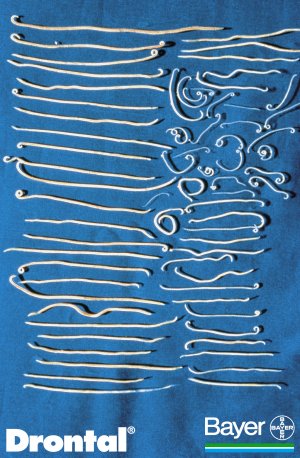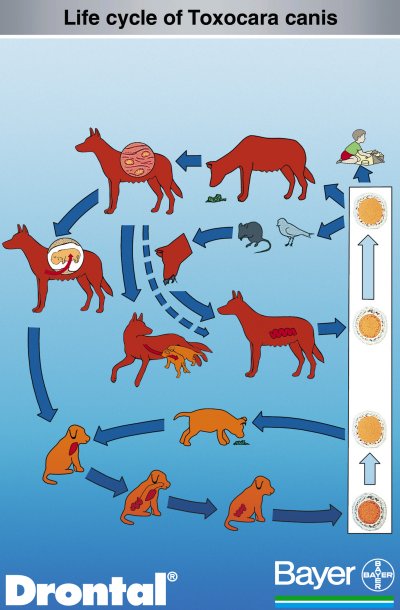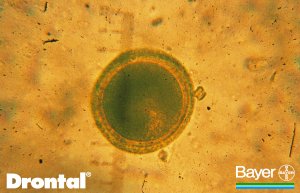
|
TOXOCARA CANIS
Note for Pet Owners: This information is provided
by Provet for educational purposes only.
You should seek the advice
of your veterinarian if your pet is ill as only he or she can correctly
advise on the diagnosis and recommend the treatment that is most
appropriate for your pet.
Toxocara canis is a common worm infection in dogs. Infective stages of this parasite can be found in the environment - particularly in areas frequented by large numbers of dogs - kennels, public parks and exercise areas. Children can be infected by picking up the disease from the environment or from handling dogs. ALL dogs should be routinely treated against this worm to reduce the number in the dog population and in the environment, and so reduce the risk of contact and transmission to humans. (See Zoonoses). Puppies
are often born with the disease because they can be infected whilst
still in the uterus.
Topics on this Page:
|
Description
Infection with the worm Toxocara canis is called Toxocariasis. Many dogs
(between 10-40% of adults, and up to 70% of puppies, in surveys conducted in
urban areas) have the worm present in their body but they may show no external
signs of disease. However, these dogs periodically pass the egg stage of the
worm in their faeces and so contaminate the environment and act as a source of
infection for spread to other animals.
Cause

Toxocara canis worms taken from one dog
Breed Occurrence
There are no specific breed predispositions. All dogs can be infected by Toxocara
canis and puppies are often infected before they are born.
Foxes are also infected by this worm (about 35-50% in the UK).
Signs
Young puppies are most likely to show clinical signs, and these will be worse if the puppy has a large number of worms or migrating larvae.
Signs include noisy breathing, cough, nasal discharges, vomiting, diarrhoea, stunted growth rate, distended abdomen (pot-bellied appearance), pale mucus membranes (eg gums). Sometimes infected pups have abdominal discomfort, groan when touched or lifted and are reluctant to move.
Death is rare , but has been reported and has been due to obstruction of the intestine or ulceration and perforation of the intestine wall.
Life-Cycle

- Worm eggs are passed in the faeces of dogs infected with the worm. These
eggs are very small but can be seen by examining samples of the faeces
under a microscope.

Large numbers of worm eggs are found in the environment in areas used by dogs for toilet purposes - eg grass verges, public parks, kennel areas..
- After a period of maturation in the environment these eggs become infective to other animals. This period of maturation depends upon weather conditions and environmental temperature in particular. In the UK it takes 2-3 weeks during the summer and several months during the winter. The eggs can survive for 2 years or more in the environment.
- The infective eggs are ingested by a dog and they then hatch.
- The larvae that hatch from the eggs cross the intestine wall, travel to
the liver and then on to the lungs. From the lungs:
- Some larvae are spread throughout the body via the bloodstream and end up in various tissues eg body muscles. This is the main pathway for larvae in adult dogs.
- Others larvae pass into the airways, are coughed up and then swallowed to pass back to the small intestine where they grow into mature adult worms. This is the main pathway for larvae in puppies.
- Larvae in body tissues remain dormant unless they are in a female which becomes pregnant. About 6 weeks into pregnancy the larvae become activated, cross the placenta to infect the developing fetus, and cross into milk in the mammary gland.
- Mature worms in the small intestine start shedding eggs after a few weeks. Young puppies start passing eggs in their faeces from 3 weeks of age and maximum numbers of eggs are passed at about 6-12 weeks of age.
When ingested by non-canine hosts eg rodents or humans the larvae travel to the tissues where they remain unless the new host is eaten by a canine , in which case they are reactivated. In children disease is most often recognised when a larva migrates to an eye and causes local injury.
Diagnosis
All puppies should be assumed to be infected.
Diagnosis can be confirmed by identifying Toxocara canis eggs in faeces samples. However it should be remembered that eggs are not being shed into the faeces all the time, so false negative results are possible.
Treatment
Prognosis
The prognosis is good.
Long term problems